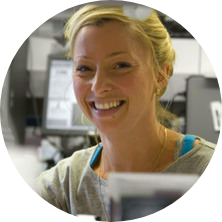Dr Samantha Stehbens
It is important to push technological boundaries to shine light into the dark corners of our understanding.
Cells in living organisms navigate highly crowded three-dimensional environments, where their coordinated migration provides the driving force behind developmental and homeostatic tissue maintenance. Cells moving in 3D environments constantly experience fluctuating bio-physical forces which they convert into bio-chemical signals in a process termed ‘mechano-sensing’, allowing cells to alter their shape to fit the physical attributes of the microenvironment.
Cells frequently need to navigate through tight or confined spaces such as pores in between matrix fibres. Our understanding of the molecular and mechanical principles of how cells
- Detect these physical limits,
- Deform their cortex whilst producing mechanical force for forward locomotion and
- Orient themselves to move through tissues, remains elusive.

Dr Samantha Stehbens
ARC Future Fellow and IMB Fellow
+61 7 3443 6938
s.stehbens@uq.edu.au
UQ Experts Profile
Our research aims to understand the fundamental principles underpinning how cells integrate chemical and physical signals from their local microenvironment to facilitate cell movement and survival. We apply these findings to understand how cancer cells exploit this to metastasise or spread to distal tissues and how the local microenvironment promotes tumour cell survival. We hypothesise that targeting the crosstalk between the cytoskeleton and the mechanical micro-environment, can be developed as an anti-metastatic approach.
Cancer cells spread aggressively through tissues by adapting their cell shape to fit the environment in addition to altering their environment so they can squeeze through tight tissue spaces. Cancer cells sense and become more invasive following changes in the biophysical properties their microenvironment including increases in stromal stiffness and interstitial fluid pressures. These changes make cancer cells mechanically compliant and adaptive to fluctuations in their surrounding environment allowing them to alter their shape to fit matrix physical attributes.
Cells have integrative mechanosensory mechanisms where key proteins undergo conformational changes or activation in response to force to induce biochemical signalling. This allows forces felt at the cell membrane to be transmitted directly through to intracellular compartments including nucleus, which itself is an elastic mechanotrasducer. Several biophysical and biochemical properties of the microtubule cytoskeleton make it an ideal structure integrate and translate these forces.

Melanoma cells endogenously tagged for fluorescent tubulin
My fundamental philosophy is that as a community of scientists, we need to highlight the role of discovery-based research in finding novel cures. I also hope to demonstrate the importance of answering difficult scientific questions using innovative approaches.
Biology is a highly dynamic process. Applying microscopy to biological questions is incredibly rewarding as ‘seeing is believing’, by simply watching- we can learn fundamental, new things. When I was younger, I fell in love with photography when my grandfather gave me his old Canon AE-1 camera with a bag of lenses, in an era before digital imaging and auto-focus. I believe learning about the depth of field, shutter speeds and exposure times (film speed in those days) lay the groundwork for my immediate familiarity with microscopy.
During high school, I never actually took biology as a subject- instead, studying math, chemistry and physics. I really enjoyed the complex problem-solving aspects of physics but the real-world application of it didn’t really appeal to me. I ended up completing a physiology pharmacology degree at UQ, picking up biology along the way. When I was first exposed to cell biology, I was completely enamoured with the complexities of how signals from the outside were transmitted inside cells. Then as a research project student, the first time I looked down a microscope at cells I had fluorescently labelled for the actin cytoskeleton- I was hooked. It was a sliding-doors moment for me. Finally- a career that combined my appreciation of photography with science.
In my graduate work, I worked on a project investigating the microtubule cytoskeleton. In the early-mid 2000s the synergy of two things defined my future research career 1) microtubule +TIPs- proteins that look like cell fireworks- were discovered, and 2) live-cell fluorescence microscopy was rapidly developing.
During my post-doc at UCSF, I worked on microtubule targeting of cell adhesions and I routinely attended the “Signalling by Adhesion Receptors” Gordon Conference. This is where I first learnt about the complexities of mechanobiology- how cells transmit physical forces into biochemical signalling to drive biological events such as cell migration. Using imaging-based methods to understand how cells feel their environment to move and how cancer cells might exploit this, remains a strong focus of my work.
The ultimate goal of my research is to build an interdisciplinary team of fundamental cell biologists, optical physicists, and computational biologists whom work closely with clinicians to generate scientific findings that challenges existing paradigms regarding our understanding of cell migration and cancer, to facilitate discovery-based treatments for patients.
Squish and squeeze: Cell membrane labelled melanoma cells squeezing through microchannel pores
Our team focuses on- at the molecular level- how the microtubule cytoskeleton and microtubule associated proteins called +TIPs, regulate how cells move through physically challenging environments. To do this we utilize cutting-edge methodology including microchannel fabrication, novel light sheet microscopy, quantitative imaging methods in combination with patient-derived cell and 3D hydrogel models to recapitulate the 3D microenvironment.
